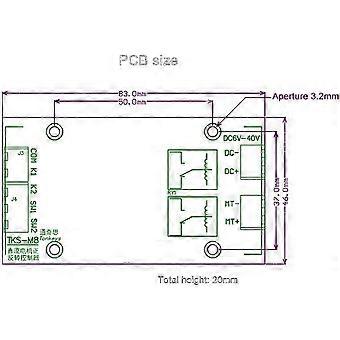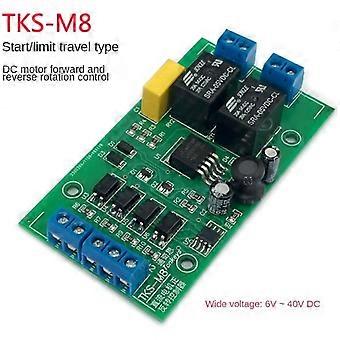Descrição
PO version (Self-locking) — Product Description and Key Details
Key benefits
- Provides reliable self-locking control for motor direction to prevent unintended reversals or stalls.
- Simplifies external control: a momentary external forward or reverse command maintains motor motion after the switch is released, reducing operator effort.
- Clear, safety-oriented limit behavior: short or transient limit signals reliably stop motion and require intentional restart, avoiding accidental restarts.
How it works (functional summary)
- PO versions are self-locking: when an external forward switch (K1) is pressed, the motor begins a forward rotation and remains rotating after the switch is released. The motor stops only when a reverse-turn signal (K2) or the forward-turn stop signal (SW1) is received.
- Limit (stop) signals are trigger-type, level-activated inputs. If a forward rotation encounters a limit signal, motion is stopped immediately; the motor remains stopped even if the limit signal is removed. To resume forward movement, the forward rotation signal must be issued again.
- Signal logic: inputs are active low. The product accepts standard three-wire NPN normally-open (NPN-NO) sensors. Inputs K1, K2, SW1, and SW2 conform to the same active-low specification.
Features and attributes
- Function: Self-locking directional control with defined limit/stop behavior for safe and predictable motor operation.
- Compatibility: Accepts active-low control signals and three-wire NPN-NO sensors; K1, K2, SW1, SW2 are compatible with this signaling convention.
- Performance behavior: Latching forward/reverse commands until a definitive stop or opposite command is received; limit inputs act as level-activated stops that persist until a restart command.
- Size/material: Refer to the product datasheet or label for exact chassis dimensions and materials used; ensure mechanical compatibility with your installation.
- Electrical interface: Designed for active-low control inputs; check system wiring to match NPN-NO sensor outputs or equivalent active-low drivers.
Important operational notes
- A short or transient limit signal will stop motion immediately and the controller will remain in the stopped state until a new forward or reverse command (as appropriate) is applied.
- After a limit-triggered stop, removing the limit signal does not automatically restart motion.
- Use sensors and switches that provide active-low outputs (or adapt outputs to active-low) to ensure reliable operation.
- K1 = external forward command, K2 = external reverse command, SW1 = forward stop/limit, SW2 = reverse stop/limit (all follow the same active-low/sensor compatibility).
Typical applications (practical scenarios)
- Automated sliding gate: Use a momentary push-button (K1/K2) or NPN-NO sensor to start forward/reverse motion; SW1/SW2 act as final-limit switches to prevent overtravel.
- Conveyor indexing and safety: Motor advances on a forward command and holds until a programmed stop or a limit switch (SW1) is reached; transient limit signals halt the conveyor and require a deliberate restart.
- Motorized valve or actuator control: Simple forward/reverse control with reliable stop signals to protect mechanical endpoints and ensure controlled restarts.
Compatibility checklist before installation
- Confirm control inputs and sensors provide active-low signals or that you can convert them to active-low.
- Verify use of three-wire NPN-NO sensors when applicable.
- Map external controls to K1 (forward), K2 (reverse), SW1 (forward limit), and SW2 (reverse limit) per the wiring diagram in your product documentation.
Safety and troubleshooting tips
- Test limit switches and sensors for correct active-low operation before commissioning.
- If the motor does not restart after a stop, ensure the appropriate forward/reverse command is reissued (the system will not auto-restart when a limit clears).
- Consult the product wiring diagram and electrical ratings before connecting sensors or external switches.
This description preserves the PO version behavior and signal requirements: self-locking forward/reverse control, trigger-type level-activated limit signals that latch stop conditions, and active-low input compatibility including three-wire NPN-NO sensors for K1, K2, SW1, and SW2.
-
Identificação da Fruugo:
392781974-840135018
-
EAN:
525287158423
Entrega e Devoluções
Enviado dentro de 24 horas
Enviamos a partir de China.
Fazemos o nosso melhor para garantir que os produtos que encomendar lhe serão entregues na totalidade e conforme as suas especificações. No entanto, se receber uma encomenda incompleta ou itens diferentes dos que encomendou, ou existir qualquer outra razão pela qual não estiver satisfeito com a sua encomenda, poderá devolver a encomenda ou quaisquer produtos incluídos na mesma, e receber um reembolso total dos itens. Ver a política de devoluções na íntegra





